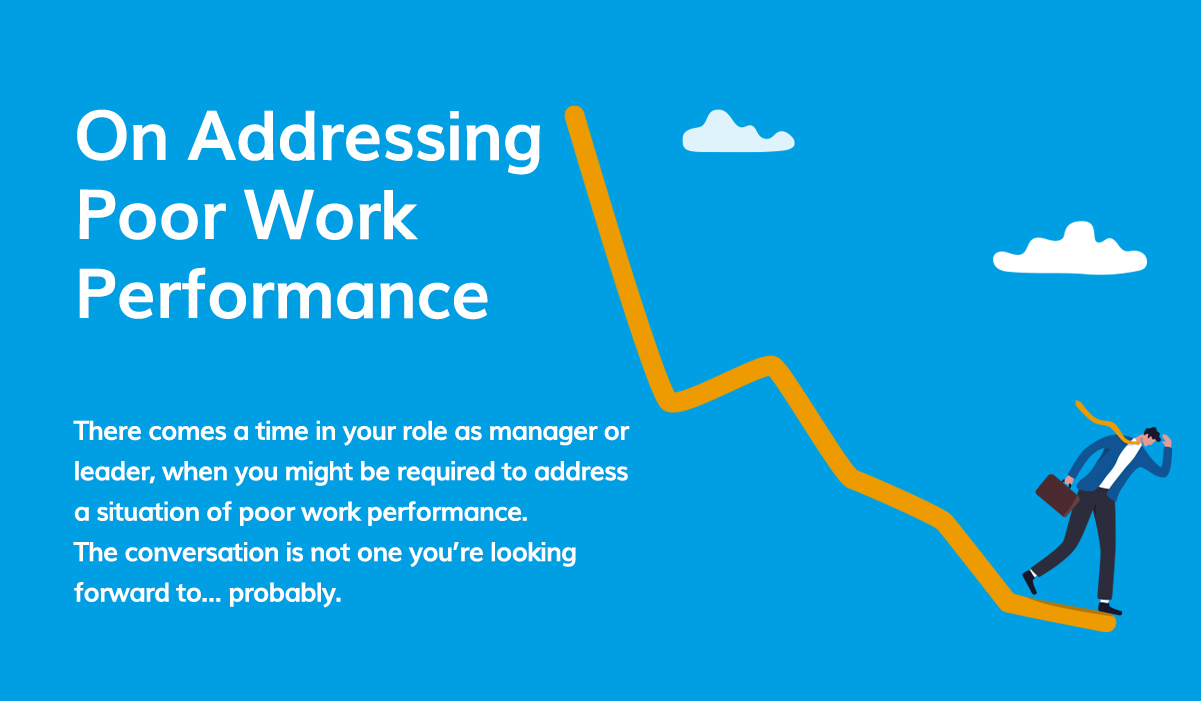There comes a time in your role as manager or leader when you might be required to address a situation of poor work performance. The conversation is not one you’re looking forward to… probably. We get it, it’s uncomfortable, but you know the situation must be handled. Here’s what to keep in mind.
Recognise that you may be on your own.
You might not want to hear this but, the likelihood is that the company’s prescribed ways of handling underperformers might not work in this particular case. Chances are that you will need to figure this out on your own, as Joseph Weintraub, a professor of management and organizational behaviour at Babson College and coauthor of the book, The Coaching Manager: Developing Top Talent in Business, points out. In the face of this, don’t let it be swept under the rug! “Most performance problems aren’t dealt with directly,” says Weintraub. “More often, instead of taking action, the manager will transfer the person somewhere else or let him stay put without doing anything.” This is the wrong approach. Situations like this rarely resolve themselves. The likelihood is that it will just get worse. It’s best to handle it as soon as possible.
Approach each situation separately.
Firstly, remember that you can’t address poor work performance in a one-size-fits-all manner. Each situation is unique, and it’s important to be flexible in your approach. For example, if you’re dealing with an employee who has been underperforming for some time and has been given plenty of warnings and time to improve, then you may need to take more drastic measures such as termination of employment. On the other hand, if an employee has just started working at your company or was recently promoted into a leadership role where they have direct reports who depend on them for guidance and mentorship – you might want to handle this situation differently than if they had been causing problems for years without any consequences.
In order to figure out what approach works best for each situation (and also determine whether or not there is even anything wrong), ask yourself these questions:
- What are my goals? What do I want from this conversation? Is getting my message across enough or do I need something more drastic like firing someone because their performance isn’t meeting expectations anymore?
- How does this person react when confronted about things going wrong with them being involved?
What to do if you’re in a position to give negative feedback.
If you’re in a position to give negative feedback, here are some tips for how to do it:
- Be specific about the issue. Don’t just say “the work isn’t up to par” – that doesn’t help anyone. Instead, be as detailed as possible about what’s wrong with their performance, why it matters and what they can do differently next time.
-
Be constructive. Don’t just point out what went wrong; also suggest ways in which they could improve their work or solve whatever problems they encountered during the task at hand (for example: “If I were in your shoes, here’s what I might do differently next time”). This will help them see themselves as capable of improving rather than incapable because they have no hope whatsoever!
- Set a time for discussion and follow through on that commitment (even if it means rescheduling). This sends the message that their performance is important enough for you both to put aside other things on your agenda so that this problem can be addressed directly and professionally at its root cause rather than simply sweeping under the rug until another day or week passes by when hopefully everything will magically get better on its own accord without any further action required from either party involved in this process of improvement/change…
How to give negative feedback without sounding harsh or condescending.
When you’re ready to give negative feedback, there are a few things you can do to make sure the interaction goes smoothly.
First, ask open-ended questions that will get your employee talking about the issue. This will help them feel like they’re being heard and understood by you. Then, be specific about what behaviour needs to change in order for their performance to improve. Finally, give your employee an opportunity to respond before moving on with your discussion – you’ll both learn more if they have time for questions or comments at this point in the conversation! Finally don’t forget about yourself: make sure that your body language and tone of voice reflect what words are coming out of your mouth. If there’s tension between these two things (i.e., if it seems like something else besides what’s being said), then try taking a deep breath before continuing.
How to address poor work performance with an employee.
- Set the tone for the meeting.
- Be clear about what you want to discuss and achieve.
- Give the employee a chance to respond and be heard, without interrupting them or talking over them.
- Look for solutions together that work for both of you, rather than focusing on fault or blame.
Finally…
It’s possible to give feedback and still show respect for the person receiving it.
The best way to give feedback is in a private place and in a calm, respectful manner. You should also give feedback in a way that is helpful and constructive rather than accusatory or overly critical.
You might think that the only way you can show respect for someone receiving your criticism is by keeping quiet. But this isn’t true at all – you can still show respect for them even when you’re giving them negative feedback!
Have an interesting observation to share? Submit your own article here.


